Behind The Scenes With Terry Shannon: Metal Detecting After a Hurricane
Published by Sam Jacobs on 09/22/20
“For those of us that detect, bad weather is our friend.” – Terry Shannon. In efforts to gather insight on metal detecting after a hurricane, we interviewed expert Terry Shannon for detailed advice and experience on the matter. Terry is a detecting expert of 15 years and book author of Detecting The Treasure Coast Terry Shannon. The following are answers from Terry to questions that Kellyco came up with in order to guide our customers during hurricane season:
1. How far off the coast do you think objects are traveling underwater before hitting the beach during a hurricane?
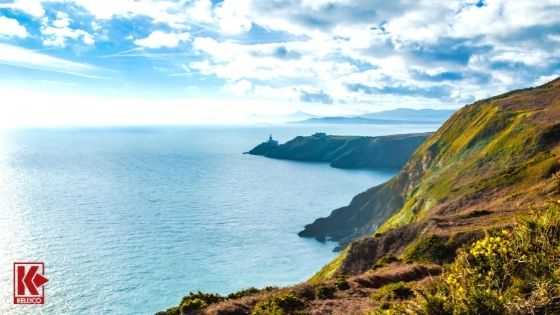
Coast
Before I begin, I want to tell you that the answers I give on metal detecting after a hurricane are my opinion based on 15 years of experience detecting the treasure coast and are my opinion only. The above question can be hard to answer and really if your goal is searching for Spanish Treasure most of these ships sank very close to shore with part of one actually coming to rest on the shore itself. It was used as a base for the Spanish salvage operation right after the hurricane in 1715. There is no question that during the storms there were items washed ashore, but high waves and surges will continue to bring more items ashore. I believe very strongly that items are washed south along the shoreline during the winter months and are washed north during weather events each summer. It is said that gold always remains where it was lost however I don’t agree, I believe that gold can travel great distances and I have experienced twice where I knew where a gold ring was lost and it was eventually found much further away. For those of us that detect, bad weather is our friend.
2. How much shore sand can be moved around during a heavy storm?
An unbelievable amount of sand can be moved when the winds run along the beach and this is key when metal detecting after a hurricane. During high wind event cuts, ten to fifteen feet is not uncommon.
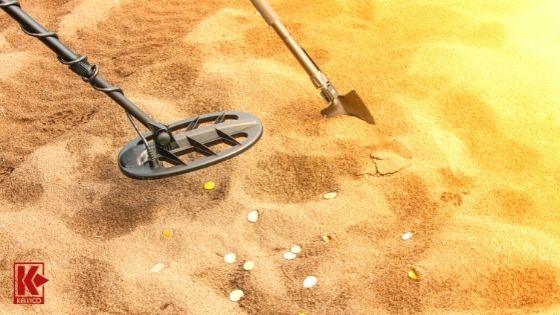
Items Previously Buried
These cuts can really produce, if you are detecting right after the wind event you are probably detecting ground that has been covered for many years. During the winter months, cuts are much smaller and should be detected. Items washing in will often hit the cut and bounce back a short way, or you may find items previously buried that are now within reach of your detector because of the sand movement.
While metal detecting after hurricanes, you will also see sand movement with a straight onshore wind that will form what I call a bowl and will wash the sand out forming a low area. These so-called bowls are caused by what are called rip tides. The waves wash in and as they flow back out, they drag sand with them. Of all the things to watch for, this is probably the most important because these will form basically all year long. I call them bowls since they are often shaped like half of a bowl, but I have seen several bowls that extended over a large area. When these bowls form, they will often work their way back close to the dunes. What you now have is an area where the sand has been washed away and you can now reach areas with your detector that have been covered for years. Often you will see fishermen fishing these low areas because small fish will feed on the nutrients washed out, and of course big fish feed on the small fish. A good bowl is often a great opportunity for those of us with a detector.
<<< Read more: Metal Detecting After the Hurricane: An Equipment Guide >>>
3. Which tides are best for hunting immediately after a hurricane?
When metal detecting after a hurricane, I believe in taking advantage of the low tides, and I usually start high about three hours before low tide and follow the waves out. As the tide goes out, it is dropping sand and by following the waves out your detector will be able to reach targets before they are covered once again. Recovery is often difficult and you’re going to get wet, but this technique increases your chances of making a good find. When you are on the beach before low tide you will often run into a steep slope down to the water. By the time it’s low tide you will notice that the steep slope is no longer there, it has been filled in by the reclining tide. After a hurricane, I personally would spend all day out there regardless of the tides and would hunt high and low. You have just had a major beach changing event and you should take as much advantage to it as you can.
4. Are certain wind conditions or directions best for uncovering more treasure?
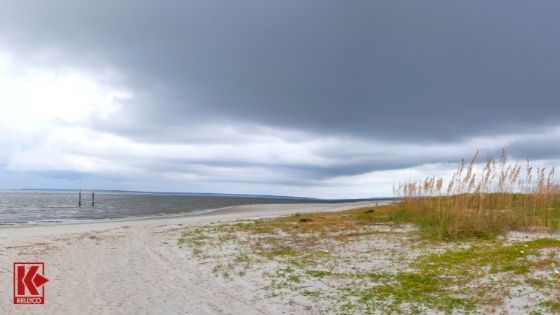
Coastal Storm
The wind plays a very important part in the planning stage of metal detecting after a hurricane. When beach hunting after a coastal storm, keep in mind that a strong north wind will cause the waves to run parallel to the beach will move sand and this is the wind direction and wave action that will form cuts. The same holds true for a south wind, if the winds are strong enough to change the angle of the waves that hit the beach, you’re going to get more sand movement. For example, if the winds result in only a one-foot cut, your detector is now reaching one foot deeper than it would before the cut. Any sand movement is good and it is the winds and resulting waves that cause this. Pay attention to the wind direction and resulting wave action.
5. We see people surfing during a big storm. Is it safe to detect during a big storm?
This question can be answered in one word and that is: NO! There are several factors that should be taken into consideration. Number one, if there is any lighting then definitely don’t go metal detecting after a hurricane until everything is clear. If you get there early and the storm is still forming all of a sudden you might find yourself in big trouble as the storm intensifies.
Also, I believe that surfing should be practiced with others, it is a wonderful sport but if you find yourself in trouble it’s not only nice to have help but very important. Fewer people will be out there during a storm and if you get in trouble there probably won’t be the help that you need. Be safe out there.
6. Are there any signs in weather reports that detectorists can be on the lookout for when planning a potential trip to the beach?
Use Technology for Basic Information
As a resource for metal detecting after a hurricane, there are several good weather and tide sites that I have saved on my phone. Weather Bug and Saltwater Tides are the two I use the most and those are for basic information. If you are planning a trip to detect the coast, one of the main factors you should take into consideration is the moon Impact.
Consider The Impact of the Moon
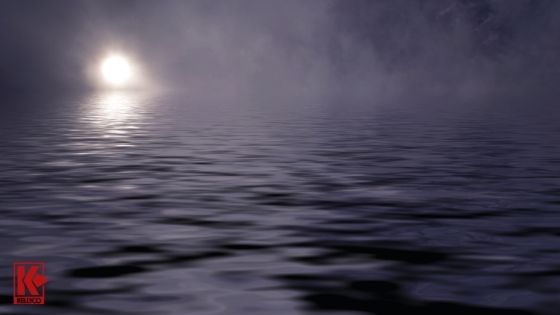
Impact Of The Moon
When we have a full moon or a new moon, the tides are going to come up much higher and will go out much farther at low tide. During a new moon and full moon, the gravitational force of the sun and moon act together creating stronger tides. I have preached hunting low following the tides out, and this works well, but a lot of my really good finds have been found up high. However, to be successful hunting up high, there are several things that must come together. First, you need sand movement. If an artifact has been lying right on top for the past three hundred years, chances are someone would have already found it. So, we need big waves and high tides to reach a high area to remove the top surface sand. Now, this is all very basic and really a no-brainer if you just give it some thought. There is one other factor that we don’t often think about. At least I didn’t until it came up and resulted in my detecting partners and myself finding five Spanish coins. All these coins were up high and lying right on top of the sand above the high tide line.
When you are walking along the shore most of the waves will come up to a certain point and then recede, but every so often a really big wave can change everything. I have been hit by these rogue waves several times and once my scoop was even ripped right out of my hands. I believe that these waves will create enough force that they will wash things out depositing them above the normal high tide line. I also believe that they create enough force that they can wash things out of the dunes. Granted, it’s usually the combination of all factors that results in good treasure finds.
This unusual event happened right toward the end of the full moon cycle and every day after that the high tide line wasn’t as high. I thought there would be at least two weeks before these conditions could repeat themselves so I had a two-week window where it might pay to detect up that high. I did this for a couple of weeks covering a huge stretch of beach and was rewarded with some excellent detecting but found nothing nearly as exciting as the Spanish coins found earlier. I had been detecting this area for years. I wonder how often these conditions were repeated and I had missed some great opportunities by not being aware of this? Pay attention to the weather. If you are planning a trip to the Treasure Coast, try to time it during a full moon phase. I have written a book Detecting the Treasure Coast that explains the moon factor and many other tips to help you be successful. The book is available at Kellyco or Amazon.
7. Are there hurricane-like conditions, like a Northeaster, that also churn up treasure?
The best way for me to answer this question is to tell a story about a three day storm I experienced the second year I was detecting the Treasure Coast:
Three Day Storm

Spanish Coin
My wife and I were still living right on the beach in our fifth wheel camper when we experienced a three-day storm. High winds out of the north caused some major beach erosion. On the fourth day, I was back on the beach right in front of our camper, digging steadily. I found so many heavy lead sinkers that I started dumping them into a five-gallon plastic pail. I was finding lots of old silver coins, mercury dimes, Barber dimes, silver quarters, it was just unreal. Everything was right. I had erosion, gobs of sinkers, old silver coins, and gold rings. I was detecting right at the base of a cut that was as high as my head. People were on the beach waiting for liftoff from Cape Kennedy.
It’s kind of a blur when you are finding this many targets and your retrieval gets mechanical; dig, pull the scoop to the side, swing the coil over the hole, lift the scoop, shake out the sand, and take a look-see.
Then it happened, I had just found my first Spanish Coin: a dated two real. If you look at the lower right side you can just make out the date, 701. I showed my coin to a well-known archaeologist near my home in Florida and he later called me and asked me to bring the coin over to his home. He said that he thought the coin was pretty rare and he wanted to double-check it. As it turns out, it’s the only coin of that date and mintmark known to exist. I don’t know if that makes it more valuable, but it really doesn’t matter because it was my first and I have no intention of ever selling it.
Here it is after I had it cleaned and put into a Bezel and then talk about luck I found a 10 Kt gold chain and I now wear both proudly.
I also found five rings that day, with this fantastic old mine-cut ring being the best of the bunch. So yes, a Northeastern can be a real gift for those of us that detect the Treasure Coast Beaches, look what a day I had because of a Northeastern.
8. Are there any groups dedicated to chasing hurricanes?
There are tornado storm chasers in Tornado Alley however, I don’t know of any groups specfic to chasing hurricanes.
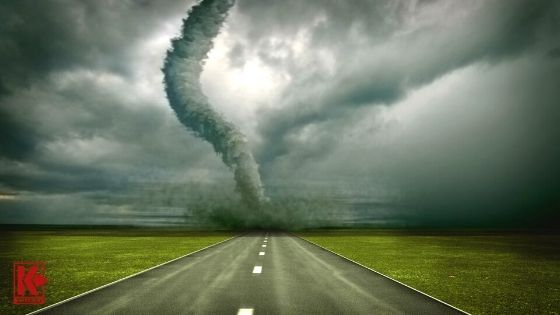
Tornado Storm Chasers
I believe everyone with a metal detector that detects the Treasure Coast will fall into that category. As I am writing this the Treasure Coast is getting a real weather event. Strong winds out of the northeast with waves up to 11 feet are forecasted. I’m a snowbird and live in Minnesota during the summer months. I have been hearing from friends for over a week talking about the upcoming weather event. Today the first day of the event I have received several phone calls or text messages and three emails telling me what the beach conditions are. I enjoy having many friends with like interests and we all share with eachother this weather information. I believe everyone that detects will have a circle of friends and they will communicate with each and what we have is many small groups of treasure chasers.
Final Word
Kellyco prepared some excellent questions about hurricanes and weather conditions that would affect our beaches and detecting opportunities. I have tried to answer these questions to the best of my abilities, but again all answers are my opinion based on what I have experienced in my years of detecting the Treasure Coast. I wish you all the best of luck out there.
Respectively, Terry Shannon
